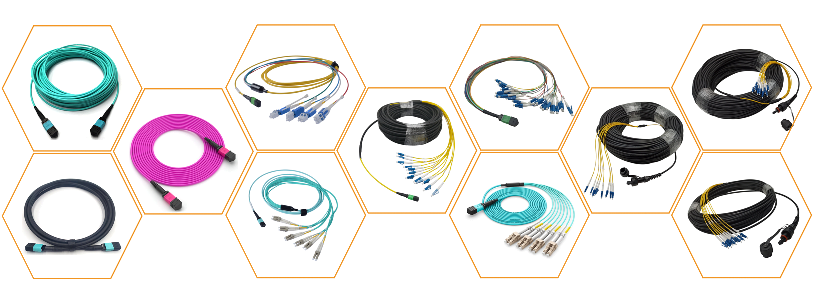Introduction
Optical fiber patch cords are the cables that connect two optical transceivers to each other. They are usually installed in a data center or telecom room, where they help connect servers, switches and routers. Mefiberoptic is one of the leading providers of high quality MTP/MPO patch cords and LC-LC multimode patch cords that can meet your needs for both indoor and outdoor installation applications.
MPO Patch Cords are the cables that are pre-connected to the MPO connectors on both ends.
MPO patch cords are the cables that are pre-connected to the MPO connectors on both ends. They are used to connect devices and equipment with MPO connectors. They can also be used in high density applications, where it is not practical or cost effective to terminate each cable individually.
MPO patch cords come in various lengths, allowing them to be customized based on the requirements of your installation.
MPO-MPO patch cables are optimized for high density interconnects.
The term high density interconnect refers to a fiber optic cable with an even distribution of fiber strands, which allows for consistent and reliable connections. High density interconnects have been used in data centers since the early 2000s, when the world was experiencing a major boom in technological development.
High density interfaces are necessary for data centers because they allow you to connect multiple devices more efficiently than with older technologies. When it comes to networking equipment like routers, switches and firewalls, you’ll need fewer devices if you’re using high-density cables instead of single-fiber ones. It’s also easier to install these types of patches since they don’t require as much planning before being installed as lower density cables do; all this makes them better suited for large scale networks where many different components must collaborate seamlessly together without delay or interference from other parts
MPO patch cords can be built with either multimode or singlemode fibers.
Both types of fiber are available in a number of sizes, including 62.5/125 µm and 50/125 µm.
- Multimode patch cords are useful for shorter distances because they can be built with multiple fibers, allowing you to use less cable and reduce costs. However, since each fiber is capable of transmitting data at a different rate, the total bandwidth will be lower than if you had used a single mode fiber on its own.
- Single mode patch cords have higher bandwidth than their multimode cousins because they transmit light through only one core (the center portion) rather than using several cores like the multimode cables do. This makes it possible to transfer data at very high speeds over longer distances compared to other types of network cables such as Cat5E or Cat6A Ethernet cable
The MPO connector is a multi-fiber connector designed to mate with the MPO adapter and provide high density connectivity between devices or equipment.
The MPO connector is a multi-fiber connector designed to mate with the MPO adapter and provide high density connectivity between devices or equipment.
The application for this type of interface includes data center, enterprise and campus applications. The MPO patch cord is used in high density fiber patching applications such as backbone cabling, server farms, network closets and fiber channel switches.
Many people often get confused with different terms like MPO cable, MPO patch cord, and MPO trunk cable.
Many people often get confused with different terms like MPO cable, MPO patch cord, and MPO trunk cable. However, it is important to know what each one of them means in order to understand the difference between them.
MPO cable: This is a type of fiber optic cable that is used to connect an MPO adapter to an MPO connector. It consists of 8 fibers which are combined together inside the jacket and then strengthened by heat shrink tubing at both ends so that they do not feel loose or fall apart when handled or connected/disconnected frequently.
The reason why these cables are named ‘MPO’ (Multi-fiber Push On) is because they have connectors at both ends unlike traditional single-fiber cables where there would be only one connector on each end so this makes it easier for installation purposes since you don’t need any tools or special items like clips etcetera while connecting two pieces together because all you need to do is push on it until both sides lock securely into place – thus making it possible for anyone who wants their own network set up easily without having any technical knowledge about how things work behind the scenes.*
MPO fiber optic cable assemblies comply with IEC 61754-7, TIA 604-5 and JIS C5973 standards, which ensure their low IL and high return loss.
MPO fiber optic cable assemblies comply with IEC 61754-7, TIA 604-5 and JIS C5973 standards, which ensure their low IL and high return loss. The MPO connectors are designed for use in the latest multimode fiber optic equipment. These connectors provide an easier port identification compared to ST or FC based on their different shapes.
Mefiberoptic provides you with a wide range of products for data centers, campus networks and SAN/LAN applications particularly in higher density fiber patching applications.
Mefiberoptic provides you with a wide range of products for data centers, campus networks and SAN/LAN applications particularly in higher density fiber patching applications.
Mefiberoptic provides a wide range of products for data centers, campus networks and SAN/LAN applications in higher density fiber patching applications.
If you don’t know how to choose your fiber optic patch cords based on your specific requirements, check out this patch cord selection guide
Oops! Click Regenerate Content below to try generating this section again.
Conclusion
Mefiberoptic offers a wide range of MPO patch cords. If you don’t know how to choose your fiber optic patch cords based on your specific requirements, check out this patch cord selection guide.

